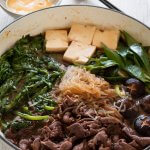
- 90ml (3oz) each of sake, mirin and soy sauce
- 3 tbsp sugar
- 50ml (1.7oz) dashi stock (note 1)
- 250g (0.6lb) beef, very thinly sliced (note 2)
- 2-3 stems of shallots (scallions), about 140g (4.9oz)
- 4 shiitake mushrooms
- 1 pack of shirataki (konyaku yum noodles), 350g (12.3oz) (note 3)
- 150g (5.3oz) shungiku (edible chrysanthemum leaves, note 4)
- ½ pack of firm tofu , 150g (5.3oz)
- 1 tbsp cooking oil (note 5)
- 50ml (1.7oz) dashi stock (note 1) or water to adjust flavour if required
- 2 eggs
-
Add all the Warishita ingredients in a small pot and boil over high heat.
-
After letting it boil for 5 seconds or so, turn the heat off and put aside until required.
-
Beef: If each slice of beef is very large, cut it into two. A slice larger than your palm might be too big to handle when eating.
-
Shallots: discard the roots and slice shallots diagonally into about 5cm (2”) lengths.
-
Shiitake mushrooms: Chop off the stems of shiitake mushrooms. To decorate shiitake head (optional), make a shallow v-shape cut in the middle of the head, then another v-shape cut perpendicular to the first cut, making a cross (see the photo in the post).
-
Shirataki: Rinse shirataki in water. Spread the noodles on the cutting board, about 20cm (8’) wide, and cut them in half. This is to shorten the noodles so that you can pick them up easily when eating.
-
Shungiku: Trim the end of the stem. Cut shungiku into about 10cm (4”). If the stems are extremely thick, like 1-1.5cm (½”) thickness, cut the stem vertically in half.
-
Tofu: Cut the tofu block into two, then cut again perpendicular to the first cut making 4 small blocks.
-
Group each ingredient together on a large plate.
-
Place each egg in a small bowl in which the individual can beat the egg and dip sukiyaki.
-
Heat a large fry pan with heavy base or shallow cast iron pot/casserole over high heat and add oil.
-
Sauté beef slices to lightly brown on each side, about 30 seconds. Add shallots and sauté for 15 seconds.
-
Add warishita and the remaining ingredients except shungiku, clustering each ingredient together for better presentation (if you wish).
-
Once the sauce starts boiling, turn the heat down to simmer and cook for a couple of minutes, then add shungiku.
-
Cook for another couple of minutes or until vegetables are cooked through, occasionally turning over the ingredients so that they will be cooked evenly.
-
Leave on low heat while eating sukiyaki directly from the pot. If the sauce is condensed too much to your liking, add some dashi stock or water to adjust and bring to simmer.
1. Please refer to Home Style Japanese Dashi Stock. You could also use konbu dashi which can be found in Varieties of Dashi Stock.
2. You can buy thinly sliced beef at Japanese/Asian grocery stores. If you cannot find it, you can make slices yourself. Please read my post Beef Rolls with Asparagus.
You can substitute beef with thinly sliced pork if you cannot eat beef.
3. Shirataki is made from konnyaku potato flour. Its texture is like very firm jelly. It comes in a clear bag filled with water. You can buy shirataki at Japanese/Asian grocery stores.
4. Common names of shungiku in English include garland chrysanthemum and chrysanthemum greens.
Some vegetable shops sell shungiku, often at Asian grocery stores but I find that in Sydney, it is rather seasonal (winter-spring vegetables). So I often use spinach as a substitute when I cannot find shungiku.
5. The proper way of cooking sukiyaki is to use a piece of beef fat to oil the pan. You only need about 4cm x 4cm (1½” x 1½”). If you can obtain beef fat, I strongly recommend that you use it. It will give the sukiyaki much better taste.